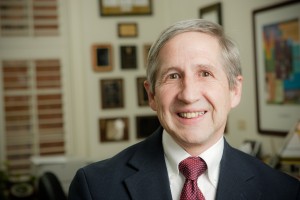Using creativity to heal the mind
A woman suffering from domestic violence acts out what is happening in her home. A man struggling with issues at work writes down what causes him stress. A child dealing with an unhappy home life draws a picture of sad stick people and then a picture of happy stick people.
Role playing (acting), writing or drawing what one is feeling can have significant therapeutic value. Professor and Chair of Counseling Samuel T. Gladding (’67, MAEd ’71) is one of the country’s leading authorities on how using the creative arts — music, dance, visual art, humor, drama and writing — can help clients become more in tune with their emotions and feelings.
“Expressing yourself through the creative arts is a way that you can control your thoughts rather than your thoughts controlling you,” Gladding said. “The creative arts are a tool to help people move on with their lives and get closure.”
The fourth edition of Gladding’s 1992 definitive book, “The Creative Arts in Counseling,” was recently published, with updated research and a new chapter that summarizes more than 100 creative activities that can be used by counselors, social workers, marriage and family therapists, and psychologists.
Sam Gladding named a Fulbright specialist
Counseling professor Ed Shaw: A new look at the five stages of grief
Read more faculty news on Inside WFU
Gladding said research has shown that using the creative arts in counseling sessions provides mental and physical benefits to the client. “It’s not just a matter of ‘this feels good.’ The research has shown that it is effective.
“For example, writing out what causes you stress has been proven to improve your immune system. Using humor has been shown to have powerful effects on your mind and body, and it decreases violence. Music can take your mind somewhere else and lessen pain. And using drama to act out your problems can be a very powerful tool in achieving closure of traumatic situations.”
Gladding regularly teaches graduate and undergraduate classes on the Creative Arts and Counseling, and he has frequently written and lectured about the topic in North America, Asia, Europe and the Middle East. He recently received the David K. Brooks Jr. Distinguished Mentor Award from the American Counseling Association.
Using the creative arts works equally well for men and women, and for any age and almost any problem, he said. Like any counseling strategy, the counselor has to determine if it’s an approach that is worth trying with a particular client. A counselor might broach the subject by first asking what a client enjoys doing; if they say drawing or painting, the counselor could then ask them to draw a picture of how they’re feeling.
The strategy can be especially effective for clients who may have trouble expressing what they’re feeling verbally. “People who see a counselor are often more ‘stuck’ than they are sick,” Gladding said. “The creative arts can help them get unstuck without their becoming unglued. In other words, the creative arts can promote insight and action that facilitates a person moving on in life.”
— By Kerry M. King (’85), Office of Communciations and External Relations
Categories: University Announcements

